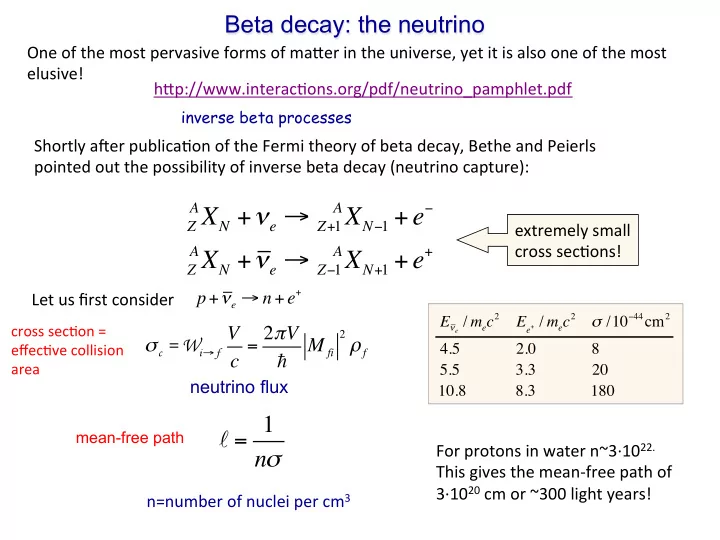

Beta decay: the neutrino One of the most pervasive forms of maUer in the universe, yet it is also one of the most elusive! hUp://www.interac:ons.org/pdf/neutrino_pamphlet.pdf inverse beta processes Shortly amer publica:on of the Fermi theory of beta decay, Bethe and Peierls pointed out the possibility of inverse beta decay (neutrino capture): A X N + ν e → Z + 1 A X N − 1 + e − extremely small Z cross sec:ons! A X N + ν e → Z − 1 A X N + 1 + e + Z p + ν e → n + e + Let us first consider E ν e / m e c 2 E e + / m e c 2 σ /10 − 44 cm 2 cross sec:on = 2 ρ f V c = 2 π V σ c = W i → f M fi effec:ve collision 4.5 2.0 8 ! area 5.5 3.3 20 neutrino flux 10.8 8.3 180 ℓ = 1 mean-free path For protons in water n~3∙10 22. n σ This gives the mean‐free path of 3∙10 20 cm or ~300 light years! n=number of nuclei per cm 3
Beta decay: (anti)neutrino detection In 1951 Fred Reines and Clyde Cowan decided to work on detecting the neutrino. Realizing that nuclear reactors could provide a flux of 10 13 antineutrinos per square centimeter per second, they mounted an experiment at the Hanford (WA) nuclear reactor in 1953. The Hanford experiment had a large background due to cosmic rays even when the reactor was off. The detector was then moved to the new Savannah River (SC) nuclear reactor in 1955. This had a well shielded location for the experiment, 11 meters from the reactor center and 12 meters underground . The target was water with CdCl 2 dissolved in it. The positron was detected by its slowing down and annihilating with an electron producing two 0.5 MeV gamma rays in opposite directions. The pair of gamma rays was detected in time coincidence in liquid scintillator above and below the water by photomultiplier tubes detecting the scintillation light. The neutron was also slowed by the water and captured by the cadmium. In the capture several gamma rays were emitted which were also detected in the scintillator as a delayed coincidence after the positron's annihilation gamma ray detection. The signal rate was about three events per hour in the entire detector and the signal-to-background ratio was about four to one. Thus in 1956 was born the field of experimental neutrino physics. This discovery was recognized by honoring Frederick Reines with the Nobel Prize in 1995 (with Martin Perl – for discovery of the tau lepton). Clyde Cowan died in 1974 … . p + ν e → n + e + a mul:coincidence measurement
Sudbury Neutrino Observatory Neutrinos do oscillate! (Ontario, 8 hours from MSU) flavor oscillations: the neutrino is composed of a combination of three different mass states Super-Kamiokande 50,000 ton tank of water located 1 km underground On February 23, 1987, the Super-Kamiokande detected, for the first time, neutrinos from a supernova (SN1987A) explosion. This observation confirmed that the theory of supernova explosion was correct and was the dawn of a new era in neutrino astronomy. SNO SNO's 2001 results were the first to directly demonstrate oscillations in solar neutrinos Cherenkov neutrino detectors 1,000 tons of heavy water; Cherenkov radiation is the optical equivalent to a sonic boom 2 km underground
Recommend
More recommend